CD FAQ
Normally these discs were manufactured exclusively for members of the BMG Club and got another catalogue number.
 |
| BMG Direct number D160616 on back of "Love, Elvis" |
In some cases it was not possible to
produce enough CDs (or the title wasn't available) so that the barcode of standard discs got pasted over with a
blank sticker.
In this way the club members could purchase these reduced discs but couldn't get
replacements in a normal store because of the sticker.
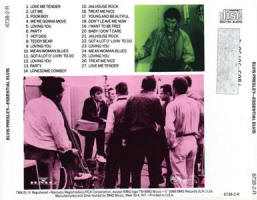 |
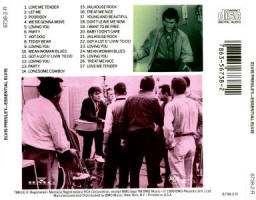 |
| Sticker above the barcode | Standard back cover |
Unfortunately these discs don't have the collector's value of a normal club CD.
This lies in the fact that everyone can create his own "Club CD" by attaching a
sticker above the barcode
By punching the barcode it is guaranteed that the disc doesn't go on sale.
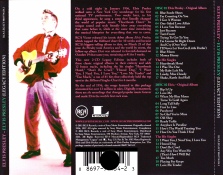 |
| Elvis Presley Legacy CD with punched code |
In individual cases it may be that not the barcode but the spines had been
punched.
Partly the barcode or the cover also got pasted over with a sticker marked with
"NFS" (Not For Sale).
Are these punched CDs more valuable?
Basically not. But it may be that a disc doesn't exist in another form (e.g. "Elvis Jukebox").
Then we have a high value for collectors.
And what about "NFS" sticker CDs?
Partly the barcode or the cover also got pasted over with a sticker marked with
"NFS" (Not For Sale).
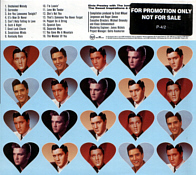 |
| Back of "Love Songs" with NFS sticker over barcode |
Since these discs are marked individually you can assume a higher value. But
since they are no "real" promo discs their value for collectors isn't as high as
for the extra pressings.
At some track listings you can see codes like this

This is the ISRC code.
The International Standard Recording Code (ISRC) is a unique identifier for music recordings where one identifying code is allocated to each version of the recording.
Using the example of "Stuck On You" we try to explain the ISRC format:
"Stuck On You" was edited in the year 2002 and used first on the CD "ELV1S - 30 #1 Hits". The song got the code US-RC1-02-00338
| US | RC1 | 02 | 00338 |
|
Country Code Two characters issued by the ISRC Agency |
Registrant Code A three character alphanumeric code issued by the ISRC Agency |
Year of Reference The last two digits of the year in which the ISRC is assigned to the track. |
Designation Code |
With some exceptions BMG and Sony used the registrant code RC1, Sony-BMG the registrant code A82.
The year of refrrerence can be the year of the recording or the year of the editing.
Where is the code stored?
The codes are encoded in the disc subcode in the disc mastering process. You need special computer software to display the codes.
Why is the code important?
You can identify whether your new CD includes new remastered songs or not. You can also find out which take of the song or which live recording is used on the sampler CD.... and much, much more.
Once an ISRC code has been assigned to a track the code should remain the same for the lifespan of the track.
Any new or materially changed recording must be provided with a new ISRC
- Remixes / Edits / Session Takes
- Changes in playing time (more or less than 10 seconds]
- Restoration of historical recordings (re-pitching, re-equalising, de-noising, de-clicking, etc.)
Is this a reliable method to identify the songs?
Yes and
no!
Generally speaking it is a reliable method, but as always it is not
flawless either.
In some cases wrong codes were used in the mastering process. For
example all codes are wrong on the 1999 issue of Elvis Presley (enhanced).
On Elvis CDs we have the IRSC code since 1994.
Unfortunately not on all releases. For example all "Follow That
Dream" CDs don't have any code.
When there are reissues of older CDs, the songs get no IRSC if the same pre-master was used.
Okay... and how can I use these information now?
Some examples:
Take the code US-A82-08-00584. This is the code from the
"Sweet Caroline" (February 16 - 1970, DS), edited in the year 2008
and first used for "On Stage - Legacy" in the year 2010
Copy and paste the code US-A82-08-00584 in our own search machine.
You find out that this song is also on various other CDs, e.g.
Elvis Golden
Stories (2011)
Elvis Uncovered (2012)
Elvis Sings... (2014)
Elvis! Elvis! Elvis! - CD Sings Singer-Songwriters (2015)
Seine 100 besten Hits (2015)
The Album Collection - CD On Stage (2016)
Or pick the low-cost CD "The 70s". There we have the song "The Next
Step Is Love" with the code US-RC1-00-00234. There is no
further information about the version on the CD.
If you paste the code in our search engine, you find the CD
"That's The Way It Is - Special Edition" where is the same
song described as live version from August 10, 1970.
For more information visit
isrc.ifpi.org
The matrix consists of numbers or letters and is pressed in the inner circle
of a CD - typically on the playing side.
The matrix is allocated freely by the manufacturing company or the pressing
plant.
Just in few cases it is possible to find out the date of production or
the country of production.
A typical Sony matrix number looks like this nowadays:
- The manufacturing company or the pressing plant
- The catalogue number or individual number
- The number of the pressing and the used stamper
 |
| A typical Sony DADC matrix from the EU or Australia |
There are illegal CDs where the matrix has been counterfeit to make it look
legal.
For this reason an IFPI number which not counts to the matrix had been
introduced (see extra faq record).
The IFPI number doesn't belong to the matrix. We list it there for a
better overview.
And what is the IFPI?
This is not easy to explain...
The SID ("Source Identification Code", today also named IFPI code -
from
International Federation of the Phonographic Industry) was developed
1994 jointly by rights owners and the optical disc industry,
primarily as an anti-piracy tool.
There exists two IFPI codes. The mastering code and the mould code.
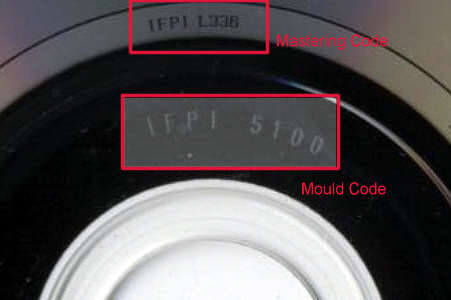 |
| Both IFPI codes on disc, seen from the palying site. |
In 1994 the mould code was introduced, in late 1994 or early 1995
also the mastering code.
The mastering code was given by the IFPI organsisation to the rights
owner and identifies the plant that manufactured the master. The
mould code identifies the plant where the disc was replicated. With
both codes you can identify the country of production and the
manufactur.
A typical mastering code has the format IFPI + L + 3 numbers, e.g.
IFPI L024
A typical mould code has the format IFPI + 4 chars (only the first
two numbers are important), e.g. IFPI 0743 or IFPI 50E4
If you take both codes (IFPI L024 + IFPI 07**), you know that the CD
was made in Germany by Sonopress.
If you only have the mastering code (L024), the CD could also have
been manufactured in South-Africa.
If you only have the mould code, the CD could also have been
manufactured by Sonopress GmbH, Arvato Digial Services or Sony BMG
Music Entertainment.
And where can I find the codes?
The mastering code can be found near the matrix, usually seen from
the playing site of the CD.
The mould code is always in the plastic ring near the hole.
Sometimes hard to see.
 |
| Both IFPI codes on disc, seen from the palying site. |
Can I be sure that I have a genuine CD if I have both codes on my
CD?
Unfortunately not! We found illegal CDs with both codes, often made in Asian countries. But also often we see, that the producer of
these illegal CD has no knowledge about the codes. They used
commonly codes which springs from their fantasy.
Pity, that we also find genuine CDs, where at times only one of the
codes was used or even none of the two. Because of this it is important that you buy your
CDs from a reliable source.
If you need more information, visit
www.ifpi.org
Legal CD shops are very rare in China. Only a few were located in
the big cities.
Most of the CDs were made illegally and sold on the
street. This applies particularly to the period before 2010.
Many
professional pressing plants produced legally during the day and
illegally at night.
We have also listed Chinese CDs on our website. Most of the CDs were
bought in legal shops. But we cannot guarantee its authenticity.
Here you can see an (easily) identified
CD fake.
Because of the language barrier and other adversities, it is very
difficult to determine a legal production.
How can you spot a fake?
That is hardly possible. Most CDs are professionally made.
It is likely a fake if the title has not been published in any other
country. But even here there are exceptions (e.g. Platinum
Collection of the Superstars in Europe and America)
The matrix of a legal Chinese (mainland) CD should be structured as follows.
Love, Elvis - Sony/BMG China, 2007

ISRC
CN-A26-07-339-00/A.J6 ifpi XXXX
| ISRC | International Standard Recording Code (CN-A26-07-339-00) |
| CN | Country code for China |
| A26 | A unique publisher code (*) |
| 07 | Recording year code (two digits, here the year 2007) |
| 339 | Record code three or four digits |
| 00 | Record item number (mostly 0) |
| A | Content Audio |
| J6 | Content Music |
| ifpi | Code from the International Federation of the Phonographic Industry |
* BMG, Sony-BMG, and Sony seems to use publisher codes A26 and
F18.
The code E04 also seems to be an official one. This code is or was used by "Shanghai
Audio-Visual Press" (上海声像
![]() ), which
was the official licensed distributor of Sony releases in China. The
same counts for E07, wich was used by the TLC / Meika group from
2002 - 2006 (美卡音像
), which
was the official licensed distributor of Sony releases in China. The
same counts for E07, wich was used by the TLC / Meika group from
2002 - 2006 (美卡音像
![]() ) and F08,
used by the Dalian Hualu Ltd. for the Goldbee label (湖南金蜂音像出版社
) and F08,
used by the Dalian Hualu Ltd. for the Goldbee label (湖南金蜂音像出版社
![]() )
)
All officially used codes are so far unknown.
Please note that all CDs should have an ISBN (International Standard
Book Number) code. This is not typical for Audio-Cds in all other
countries, but regulations in China.

Even if a CD from China has the ISRC and ISBN code ... it is still not safe
to have a legal CD.
Unfortunately, we also have no way of providing
more help.
Perhaps at some point the mystery will be resolved...
and
then we talk about Russian CDs!
☺
If you're just a music lover, you probably don't care. But if you are a CD collector this is unacceptable to you.
Since Sony Music has been the rights holder, CD-Rs have also been
released.
It started with the "Promo CD-R", which we can still accept because
these were only distributed to radio stations for advertising
purposes.
But of course we think that the pressed "Promo CDs" are more
beautiful and valuable.
This is also because anyone can make these CD-Rs.
Personally, we cannot accept that standard CDs are also released on
CD-R.
These CD-Rs are offered in the so-called "Sony Legacy Music On
Demand" program.
Some big distributors do the manufacturing for Sony, e.g. Amazon.
We asked Sony Germany about the program.
But they knew nothing about it and referred us to Sony USA.
Unfortunately, we never got an answer from there, so we had to look
for an explanation ourselves.
This is what Amazon says:
"CD-Rs and DVD-Rs (the "R" stands for "recordable") look like the
discs you're used to and offer the same audio and image quality.
This recordable media is used to manufacture titles on demand, as
fully authorized by the content provider.
Through manufacturing on demand, CreateSpace, part of the Amazon
group, enables Amazon to offer music and video content that might
not otherwise be available. Each disc comes fully packaged, with
artwork, in a standard jewel case for audio, although for reissued
products the artwork may differ from the original. All products are
manufactured from original source materials (e.g., for audio
products, uncompressed CD-quality audio). By eliminating inventory,
waste, and inefficiencies in the distribution system, on-demand
manufacturing provides the added benefit of helping preserve the
environment."
Fortunately, Amazon is ending its MOD program on August 18, 2021
Statement from Amazon "We made the decision to close MOD based on
customer and content owner feedback, specifically their preference
for digital streaming services vs. physical discs ...."
Even if a "big seller" is no longer there, please note that there
are other providers of the MOD program
e.g. Acutrack, Alliance Entertainment, Allied Vaughn, CCNow,
Kunaki, TrepStar.
We don't know if Sony is working with these manufactures too.
At now we know these Elvis CD-R made in the Music-On-Demand program:
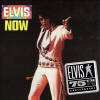 |
Elvis Now (Sony Music A761549) |
New UPC: 0190759409824 |
 |
From Elvis Presley Boulevard, Memphis, Tennessee ( Sony Music A76154) |
New UPC: 0190759410028 |
 |
You'll Never Walk Alone (Sony/BMG A689960) |
New UPC: 0190759410721 |
 |
Elvis R&B (Sony Music 82876 87255 2) |
New UPC: 0190759409923 |
 |
The 70's (Sony 88843014272) |
New UPC: 0190759410622 |
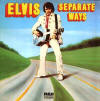 |
Separate Ways (Sony/BMG A709674) |
New UPC: 0190759410523 |
 |
An Evening Prayer (Sony Music A761423) |
New UPC: 0190759410424 |
 |
G.I. Blues (Sony Music A761558) |
New UPC: 0190759410226 |
 |
Fun In Acapulco (Sony Music A762716) |
New UPC: 0190759410127 |
 |
Girl Happy (Sony Music A761588) |
New UPC: 0190759410325 |
We apologize, but we are not going to purchase these CD-R to provide
more information.
But we will show one example here for the SONY MOD CD-R Elvis Now.
Alternate Master is also a variation.
Here the master can also consist of either one take or several takes and sounds
very similar to the master - intended as an alternative to the actual master.
Examples:
"I Beg Of You" (to be heard on the CD "Loving You" - DSD Release of 2005)
"Party" (to be heard on the CD "Loving You" re-release from 2005 with improved
DSD Sound Transfer
Takes are basically the individual recordings of a song within a session, a distinction is made between
- Alternate takes are all recordings
of a song that do not correspond to the take, which eventually becomes the
master.
Alternate takes can differ from arrangement and interpretation in places clearly to the master because a session is indeed a creative process where you try hard to finally get a usable recording.
Example: The CD box "Platinum - A Life In Music" contains the alternate take 7 from "Suspicious Minds", which does not correspond to the master take 8 - thus offers the listener the possibility to hear a variation of a song.
- Master take = final version,
intended for release.
Rehearsal: Try-out of a song within a recording session. Sometimes even used for release.
Examples: It's Diff'rent Now (to be heard on the CD box "The Essential 70's Masters - Walk A Mile In My Shoes")
And sometimes a full-fledged song develops from a rehearsal: Suspicious Minds (listen to the FTD CD "Memphis Sessions")
Informal rehearsal is basically identical - but more casually approached as it is not meant to be released. Examples: "Stranger In My Own Home Own Town" (available on the CD box "The Essential 70's Masters - Walk A Mile In My Shoes")
Jam is a spontaneous performance or recording, untested, just "off you go", mostly to "get warm, pass time, fun in between". Example: "Tiger Man" (studio) Jam 1975 (to be heard on the CD box "The Essential 70's Masters - Walk A Mile In My Shoes"
Informal jam is basically the same as a normal jam - you really do not need that classification. Example: "Lady Madonna" (to be heard on the CD box "The Essential 70's Masters - Walk A Mile In My Shoes")
"Undubbed recording" means it is without later added instruments or backing vocals or other effects. Elvis and band pure in the studio so to say. With these later added effects it is called "overdubbed" (strings, horns, violins, vocals etc., etc.)
Remake is the re-recording of a song.
Examples: "Love Letters" was originally recorded in 1966, recorded again in 1970, and of course the arrangement and performance differ from the original recording - to be heard on the CD "Love Letters From Elvis" or on the CD box "That's The Way It Is - Special Edition "
"I?ll Be Home On Christmas Day", first version was recorded on 16 May 1971 - to be heard on the CD "Elvis Sings The Wonderful World of Christmas" or the CD compilation "White Christmas". The remake dated June 10, 1971 can be heard on the CD "Memories Of Christmas".
Home recordings are, as you can imagine, private recordings with non-professional equipment, usually a simple tape recorder. But sometimes even a slightly better device (semi-professional)
is used.
A remix is a variation of a music track based on the multitrack original.
Adding or removing sound effects, adjusting the speed, rebalancing the volume balance, re-recording additional instruments or voices, or completely disassembling and recompositing the original material.
Examples: "Shake That Tambourine" on the CD "Elvis 80" or the Paul Oakenfold remix of "Rubberneckin'" and all songs on the CD "Christmas Duets".
Copy editing by Joachim
Bernecker (aka "Ciscoking")